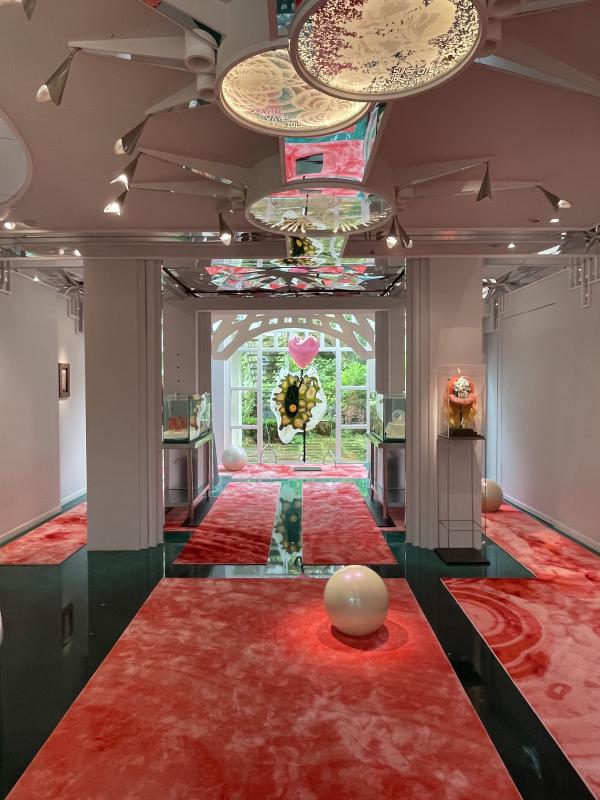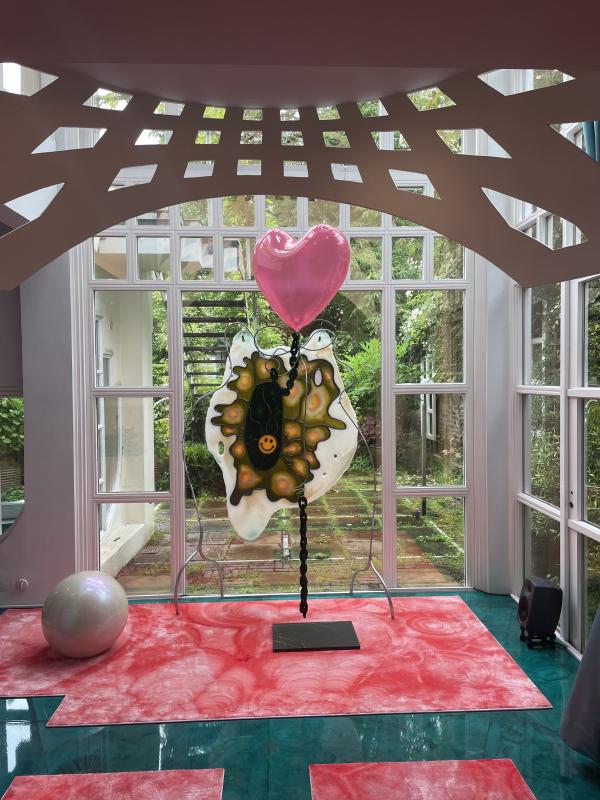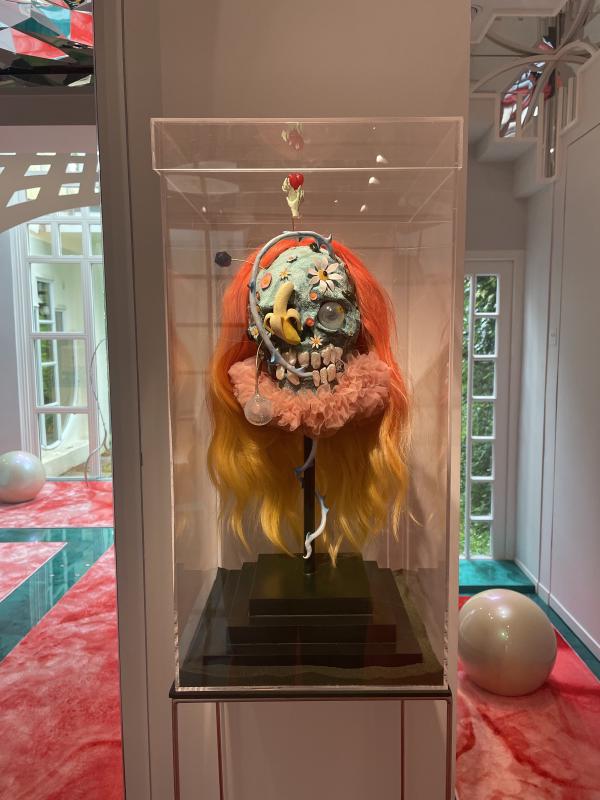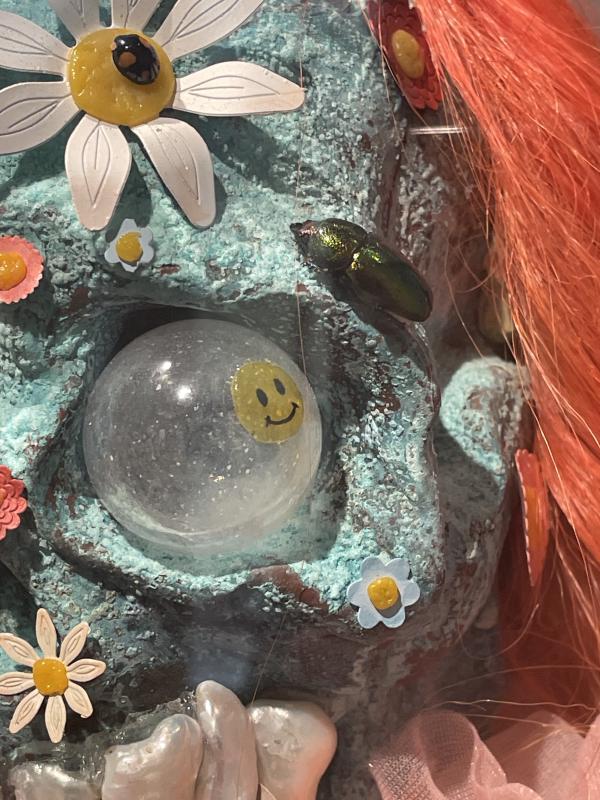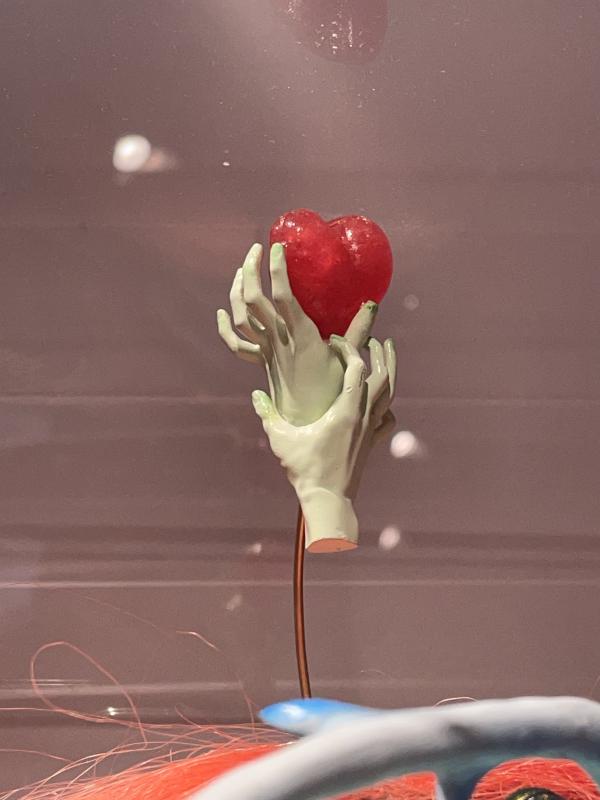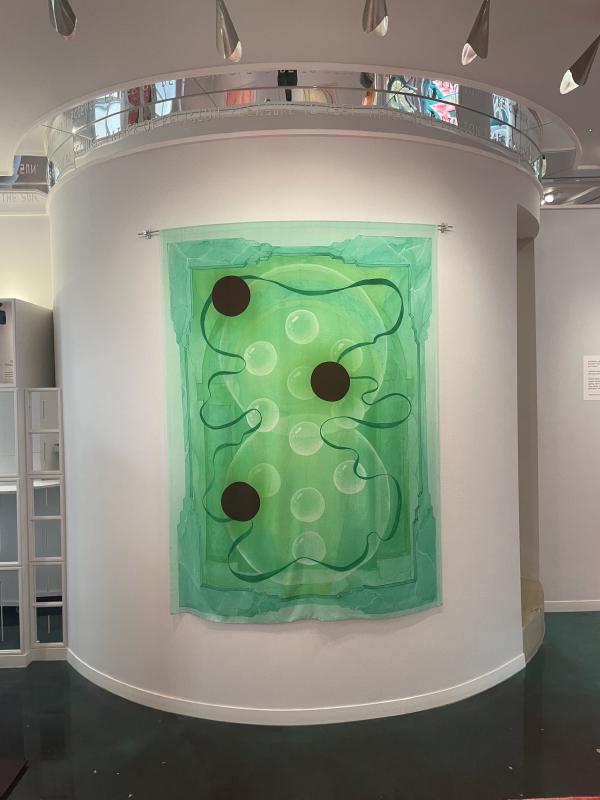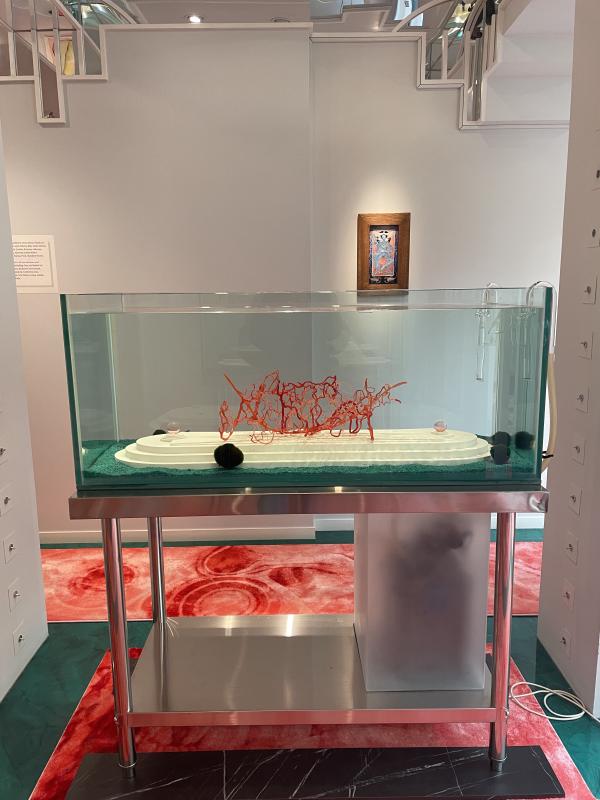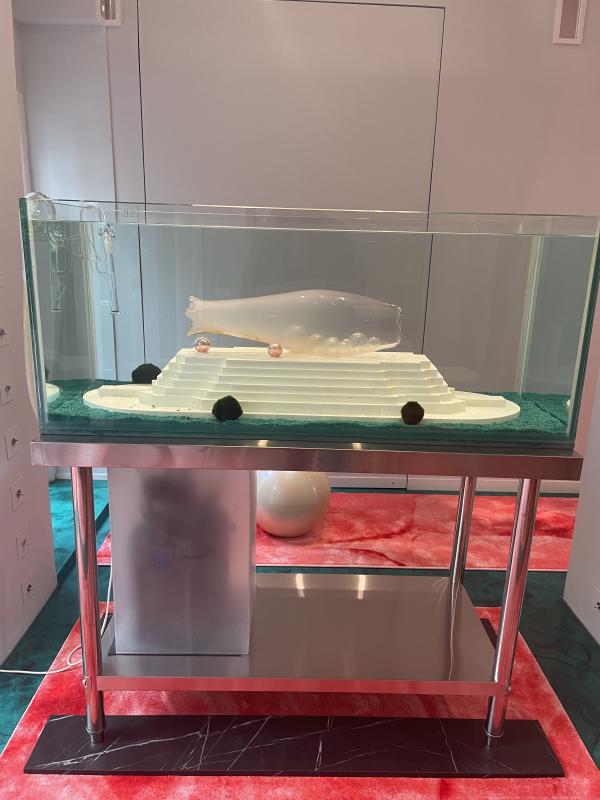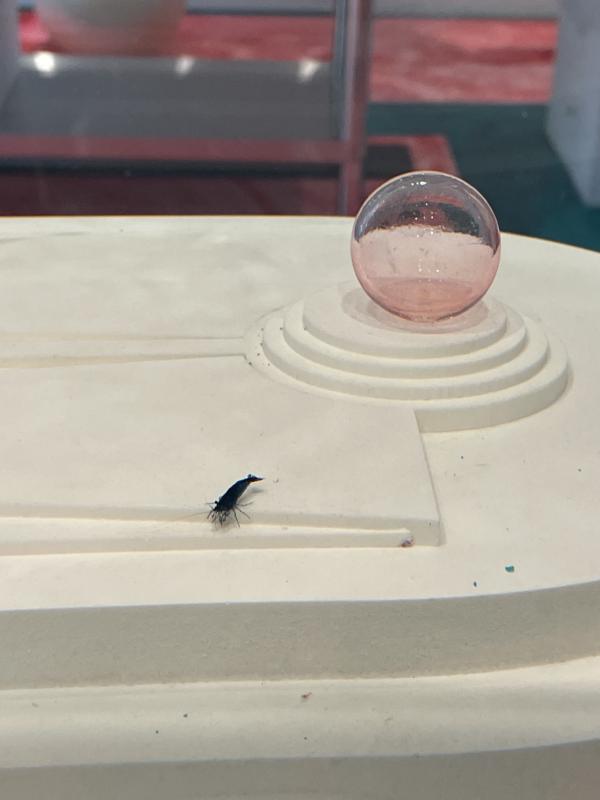Tai Shani @ The Cosmic House
ZM
I came to the Cosmic House for a kind of vicarious pleasure. 19 Lansdowne Walk, Holland Park, West London. From the outside it looks imposing, but so do all the houses round here. None of them look like my understanding of a house (none of them are pebbledashed and this isn’t really the suburbs). The Cosmic House was designed in the 70s by Charles Jencks, an American landscape architect and architectural theorist. He’s most well known for his writing about postmodernism, and a lava lamp style diagram of ‘the evolutionary tree’ of 20th century architecture. This house was his literal family home, an architectural artistic domestic collaborative project for him, his wife and their friends (fellow artists and architects, Rem Koolhaas, Terry Farrell, Eduardo Paolozzi). It’s kind of nuts and — I don’t know how to qualify that, you just have to trust me. It’s like a funhouse, it’s like an artwork of its own. I’m glad it exists but it makes me feel a bit woozy. To think that people can live like this. In and amongst it all (all the stuff, all the stimulus).
I like vicarious pleasure. I like walking through London’s residential neighbourhoods in the evening, dusk, whenever it’s getting dark out, whenever people put their lights on. I can see into their homes with flawless clarity. The window frames it all. A perfect, sweet vignette. Walking through these neighbourhoods at dusk is like walking through a gallery, like I’m looking at all the lovely paintings. Except I am watching people watch telly, gogglebox in real life. Or I am watching them make dinner, eat dinner. Argue, read books and magazines, type things on a laptop, play xbox, I am watching them drink red wine. They’re at home, luxuriating in grand domestic interiors.
I like to look but I try not to be seen. If they do see me, things can get confrontational. Mostly they just pull the curtains, dim the lights, they withdraw and take my perfect vignette away with them. But one time, a woman tapped on the window to try and shoo me away. I’m just trying to look at paintings! Behold a portrait of contemporary domestic life in modern London! Looking is a kind of consumption, a kind of vicarious pleasure. Through the window, I get to view the splendour over-there, and I get to receive it without participating. I don’t like the idea that the paintings can look back. I don’t want real life, I want the distant image of it — by thinking about it as a painting, I make it over-there — the artifice of window as vignette, three dimensional life flattened into two.
Anyway. I am down on the lower ground floor in the Cosmic House, in a long room that is now a gallery. The rest of the house isn’t a typical house, so it makes sense that the gallery isn’t a typical white cube. It has green marble floors, a mirrored ceiling, a poem in praise of the sun etched into the mirrored dado rail. It also has an installation by Tai Shani, THE WORLD TO ME WAS A SECRET: CAESIOUS, ZINNOBER, CELADON, AND VIRESCENT.
The gallery’s green floor is part covered by fleshy pink red rectangular rugs. A pink heart balloon, I think made of glass. Tethered to the ground and propped up in suspension by a twisted metal rail tied in a bow. A glassy flat pancake of a melting eye — like spat phlegm with cellular blobs, spots radiating inside out of them. In the centre, the mitochondria or the pupil (in the centre of that, a yellow smiley face). A fossilised blue skull with transparent ping pong ball eyes (one eye dangles out, replaced by a half-peeled banana), forehead studded with little plasticky flowers and gems. Its bone texture looks like oxidised copper, the visual texture of fizzy sour cola sweets. Oversized mother of pearl teeth crowding out its skeletal mouth. It is wearing a pink frilly ruff and an orange wig with beachy ombre waves. Two miniature green hands are rising out of the skull’s crown, clasping desperately onto a cartoon red heart. A silky green print hangs on a curved wall — twisting green ribbons and milky bubbles, black holes and architraving. Two pearls the size of foot stools, iridescent holographic and solid. Two fishtanks.
The fishtanks are interesting to me. They face each other, mirrored in double. Both have a raised dais, a little stepped stage to present beautiful items: one with a baby pink glass fish shape full of iridescent glass bubble eggs, the other with what looks like the fish’s veins and arteries pulled out like a twisted tangled red ribbon. Both have blue fish tank pebbles lining the bottom, both are populated by tiny blue baby shrimp. They are so small I have to get very close to the glass to see them, so close my breath fogs the glass. They are so blue. Kind of teal or royal blue, really really blue and blue all over. I didn’t know shrimp this colour even existed. But the shrimp are like the perfect true audience for this art — forced to move around it, live alongside it, luxuriate in the grand classical architecture of it, wiggling around and through their home in the weird negative space. I don’t understand their experience. For me, as a human viewer, it’s an over-there art object — I peer into their domestic environmental interior like it is a perfect, sweet vignette. But for them, ah — the space is all at a different scale.
Yeah. The fish tank recalibrates my understanding of space and scale, makes it unfold and explode. Two dimensions flop out into three. Like switching to streetview on Google Maps. It makes the space look back at me, offering itself up. Rather than looking in through a window, through a frame, at the distant image over-there — I think I am in the image, living my life amongst it, wiggling around and through my environment in the weird negative space…
I like to walk down residential streets at dusk, looking in people’s windows like they are paintings for me to behold. Vicarious pleasure, do you know what I mean? That is what I said to the shrimp in the fish tank in the gallery.
No, we don’t know. This isn’t a window or a frame, this is a whole entire room and you’re in it now baby! Oh, yeah. The shrimp are answering back. This is more than just a room, more than just negative space to negotiate co-existence with. This room is a body, or at least a reliquary for disparate body parts. Ours is a glass fish with ribbon veins, yours is a human with a glass heart. It’s all mirrored in double, it’s all very neat. Woah, yeah — the shrimp are so wise. Like benevolent custodians guiding me round the gallery.
Because, before there was art and installations, there were relics. When the Ancient Egyptians mummified their pharaohs, they’d pull out the lungs intestines stomach and liver, they’d place these organs in canopic jars and they’d place the jars in the tomb with the sarcophagus. And Christian reliquaries were really just beautiful boxes to protect and display the holy remains of a holy saint. Their finger, their bones, their crown of thorns. Both of those things are sacred arrangements of a body in space, life after death. Objects in space have always commanded human reverence. In the case of holy saints, being so full of virtue meant their bodies wouldn’t decompose. The church called it incorruptibility and it was a sign of divine intervention. Yes, the room is like a skin containing the organs and parts. Yes, the work is a kind of body and in becoming art it also becomes alive — or at least, it doesn’t decompose so quickly.
Suddenly the art is not over-there, away from me all distant in its frame. I am in the image and in the room and the room is a kind of body and it’s kind of alive and the shrimp are speaking to me about it and I think they understand the work better than I do. It’s all beyond the 2D > 3D slip, a whole other dimension is called forth/fourth (a living dimension).
The shrimp tell me that THE WORLD TO ME WAS A SECRET is a line pulled from Mary Shelley’s Frankenstein. They tell me this show responds to the Promethean impulse, the urge to make things come to life. I nod because I see it: holy magic, a miracle! Art, coming alive around me as I look — an un-vicarious, direct pleasure. I am only a shrimp, baby small and blue. Luxuriating in the grand classical domestic surroundings. It only belongs to me for a moment, as a pilgrim on my way. Soon I will be back on the residential street looking at my paintings of domestic interiors. But for now I am inside the window, inside the frame, wiggling through the negative space.
